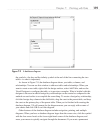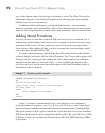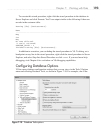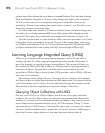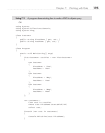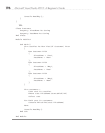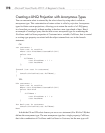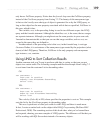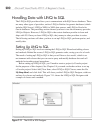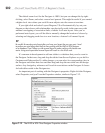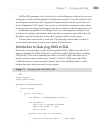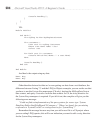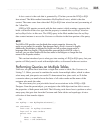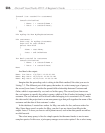
Chapter 7: Working with Data 199
only have a FullName property. Notice how the foreach loop uses the FullName property,
instead of the FirstName property from Listing 7-2. The beauty of this anonymous type
is that we don’t really care what type of object is generated for us by the LINQ query, as
long as that object has the new property associated with it that we specified, FullName in
this case, which it does.
The variable, cust, in the preceding listing is used in two different scopes: the LINQ
query and the foreach statement. Although the identifier, cust, is the same, the two usages
are separate instances. Although you might not use the same practice in your own code,
I wanted to demonstrate this so that you can see that range variables, such as cust, are
scoped to the query they are defined in.
Another nuance of the preceding code is that cust, in the foreach loop, is not type
Customer. Rather, it is an instance of the anonymous type created by the projection (select
clause) of the LINQ query. Therefore, FullName is the only property each anonymous
type instance, cust, contains.
Using LINQ to Sort Collection Results
Another common task you’ll want to perform with data is sorting so that you can put
objects in a certain order. The following example modifies the example from Listing 7-2
to sort items from the customer List in descending order:
C#:
var customers =
from cust in custList
orderby cust.FirstName descending
select cust;
VB:
Dim customers =
From cust In custList
Order By cust.FirstName Descending
Select cust
The orderby (Order By in VB) clause specifies the properties to sort on. This example
sorts the list by the FirstName property in descending order.
This was a quick taste of what you could do with LINQ, and there is much more.
In fact, I wrote an entire book on the subject titled LINQ Programming (McGraw-Hill/
Professional, 2008). The remaining section of this book takes what you’ve learned here
and expands, showing you more samples of LINQ queries. The difference will be that you
will be working with SQL Server data instead of in-memory objects.



